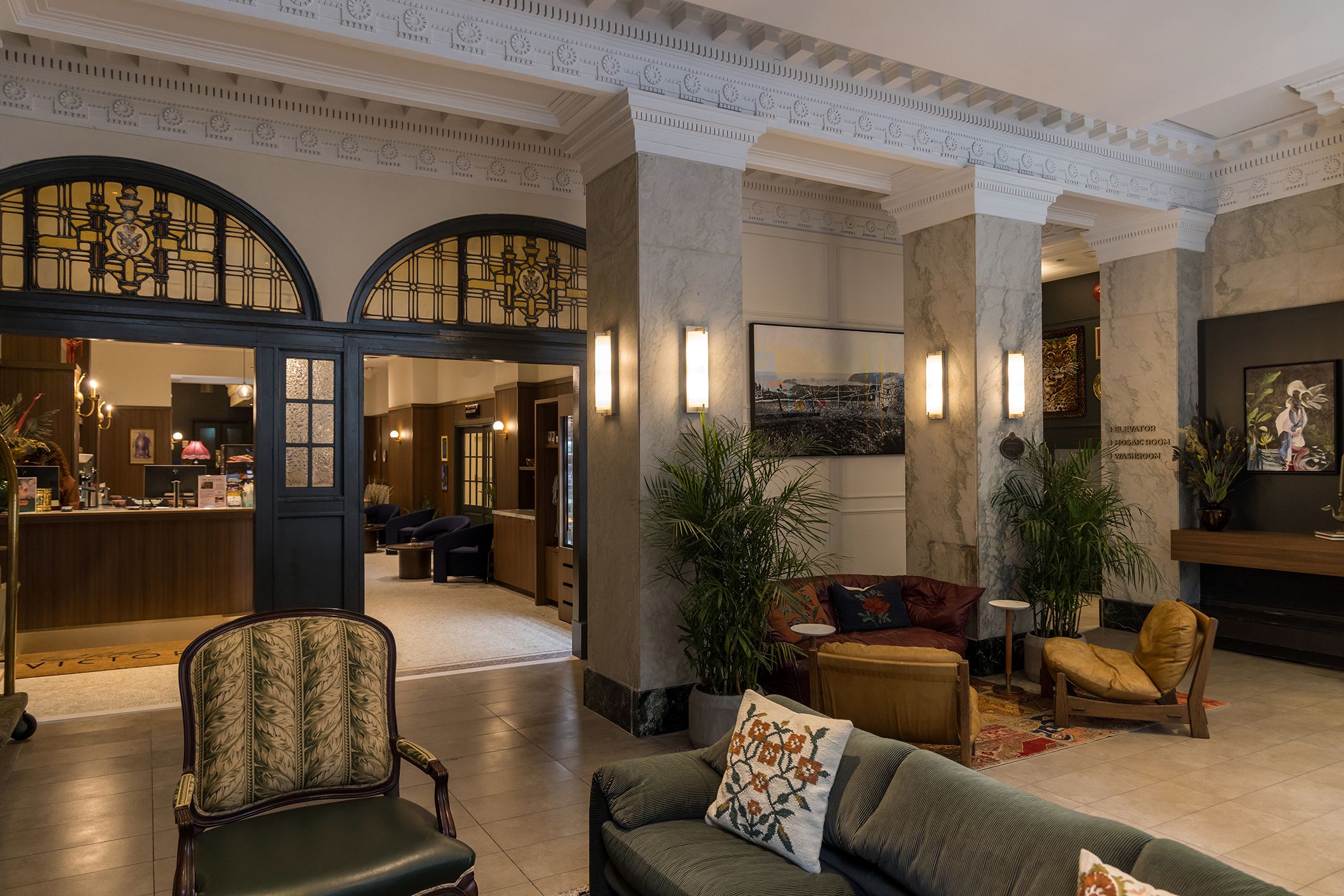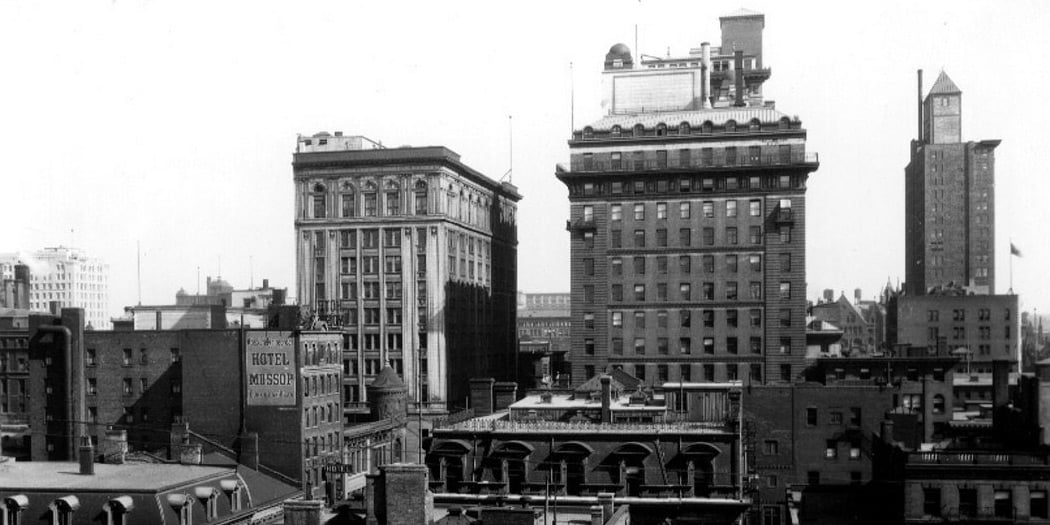

You are using an outdated browser. Please upgrade your browser to improve your experience and security.

In 1906, just two years after the Great Toronto Fire, a notice was printed in The Globe in reference to a new hotel to be erected on Yonge Street. Frederick W. Mossop [1858-1935], the proprietor of the Exchange Hotel, and a third-generation hotelier, was reported to have purchased a small, 40-foot lot just south of Melinda Street, upon which the future Hotel Mossop would be built for an estimated $100,000 [$2.5 million today]. Toronto Architect J.P. Hynes [1869-1953] was hired for the task, having made a name for himself with the construction of the Hub Hotel, Crawfor Hotel, several churches, and many elegant homes. Owing to its status as “one of the most fire-proof buildings in the Dominion” Construction magazine praised the newly opened Hotel Mossop in 1909, citing its innovation, efficient design, and employment of Canadian materials and labour. The Hotel Mossop was also noteworthy for its use of 18 concrete wells, carried down to the bed-rock, which supported the 8-storey structure. Architecturally, it was said that the hotel “[d]erives its pleasing expression from simple, straight lines, rather than from any exuberance of decorative detail,” its subtle, yet elegant design the subject of much approval.
From the viewpoint of the workmen, however, theirs was a different story. Featured in The Bridgemen’s Magazine in 1907, the journal’s editors reproduces William A. Stuart’s poetic tribute in full:
As I went walking on Yonge street one day.
I met an ironworker and to him I did say:
“Hello, Roughneck, how’s business?” He answered, “Real well,
I’m helping raise iron on Mossop’s hotel.”Our job is a union one, all hands can see
The steel being furnished by the Dominion B.C.
We hope they’ll make money, of course, time will tell,
By the time they have finished Fred Mossop’s Hotel.The Job is going up, ten stories or so.
But the way it goes up is most awfully slow;
You heave on the derrick handles and you turn to the beat- well,
When you’re raising the iron on Mossop’s Hotel.The men on the handles hardly know when to stop,
There is two or three here that came down from the shop.
And when they are there, Billy carr gives them –ll;
I guess they are not sorry they’re on Mossop’s Hotel.We had quite a mishap on our job here today,
The gang went to roll a beam out of the way,
It came over on my foot, which started to swell.
Oh, you’ve got to be spry on Fred Mossop’s Hotel.Each day as it passes; we have all sorts of fun;
Tommy Wells Is our superintendent here and keeps us on the run;
While Coburn, the cart-horse, pokes fun at “Taff” Bell,
Oh, there’s lots of good sport here on Mossop’s Hotel.I’ll proceed now to give you the name of the men,
Interspersed with a little Scotch wit now and then:
There’s Anthony Raines and others, Murray as well.
We are all bunched up together on Fred Mossop’s Hotel.There’s Coburn, the cart-horse, and champion, too.
And the language we hear would make the air blue.
There’s Jack Raines and myself and young “Laffy” Bell;
Oh, yes, we all have a say on Fred Mossop’s Hotel.There is Thomason, the blacksmith, he’s here you can see;
He has left his good home at the foot of McGee:
He’s a fine jolly blacksmith, we all like him well.
But he has lost his job now on Fred Mossop’s Hotel.Young “Taff” and Jack Raines the columns did shin
To make a connection and put some bolts in;
They couldn’t get the bolts in, the iron seemed to swell
The day we raised iron on Fred Mossop’s Hotel.For myself I must say I’m sort of a queer slob,
And today they appointed me steward on the job;
So be sure and have a good card, keep your dues paid up well,
Or you won’t work long here on Fred Mossop’s Hotel.Brave Alph McGraw, he’s the man with the rule,
Was chased by Tom Wells up to Duson street school;
I suppose when he comes back he’ll chase us to- well.
When the worst is all over on Fred Mossop’s Hotel.Well, I think I will bid you farewell for a time.
As I can’t think of much more to put in this rhyme.
Joe Moldey is our foreman, we all like him well;
Success to our union and Fred Mossop’s Hotel.— William A. Stuart
Done in good jest, the poem captured a rare first-person view from the workman’s perspective, the colourful verses forming a window into the daily life of a typical builder’s site. Thus, despite the lines in reference to danger on the job, the poem’s ending verses cheer the success of they, their union, and the hotel, all in equal measure.
In its original configuration, Hotel Mossop had three distinct entrances. The main entryway, covered by an elegant glass canopy, allowed access to the lobby and front desk, while the fully segregated ladies’ entrance was found to the right, leaving a separate entryway to the left with direct access to the hotel bar. A vestige of Edwardian Toronto, such was the norm for licensed establishments such as a hotel, they being no place for a lady – at least not without her husband. Indeed, the original floor plan for the hotel bears this out, the conspicuous lack of a main floor ladies’ room suggesting for whom the establishment was designed.
Once inside, guests were greeted with a lavish, modern interior. With a nod towards safety and style, the walls were clad with an exquisite blend of Mississquoi and Tennessee marble, the floors covered in a tile mosaic, and the front desk and other principle rooms framed by mahogany trim, all of which was tastefully lit with the help of bronze electric light fixtures. Separate sets of stairs and two elevators were provided for guests and staff, the ladies’ entrance served by its own staircase, which led up to the second-floor dining room. The upper six floors were dedicated entirely to bedrooms, the original upstairs floor plan revealing that the majority of suites featured shared bathrooms, with some of the smaller rooms having to make do with just a small wash sink. Thoroughly modern for its day, each room was equipped with a telephone with a direct line to the front desk. The walls were covered in decorative wallpaper, while the fire-proof, concrete floors were made comfortable and stylish with high-quality, felt-backed carpeting. Having ballooned from its original estimated cost of $100,000 [$2.5 million today], the final bill for Hotel Mossop was between $250,000 and $300,000 [$6-7 million today].
During what would become Fred Mossop’s relatively brief tenure, the early years of the hotel were defined by a series of colourful events, as covered by the local papers. An early morning fire alarm caused a panic among hotel guests in 1910 when an adjacent building caught fire, an elevator repairman suffered severe injuries after falling down an elevator shaft in 1912, and the hotel and its proprietor were involved in a high-profile illegal gambling case in 1914. In particular, the gambling incident stung the sharpest, Mossop himself implicated in an embarrassing scandal involving he and several high-stakes guests including then Tory hopeful A.C. Pratt. Described for his role as the “banker”over the course of what Mossop was quoted as characterizing as a series of “friendly games”, charges of illegal gambling were piled on top of allegations of dishonesty, the injured party – Mr. A.C. Pratt – claiming that he had witnessed the use of five Aces and five Kings on more than one occasion. In total, the damages sought on behalf of Mr. Pratt and the Province totalled nearly $3,600 [$81,800 today]. For his part, the defiant Mr. Mossop filed a counterclaim against Mr. Pratt for roughly $560 [$12,700 today] in outstanding personal debts.
Two years later, just a year before its sale, Mr. Mossop penned an open letter to The Globe, detailing the many undue financial hardships that he and his beloved hotel had been forced to endure, all in the face of what he reported to have been a thirty-five year track record of honest business dealings. Claiming his reputation as a “faithful observ[er] of the law”, having “never incurred even a reprimand from any court or license board”, Mossop was steadfast in his belief that he and his hotel were broadly recognized “as performing a legitimate service to the community”. Listing the financial strain of being denied an earlier request for expansion – having gone as far as to lease the adjacent Arlington Chambers, to no avail, in 1912 – on top of ever-increasing fees from the Ontario Licensing Board, Mossop warned that the end may be nigh for the Hotel Mossop. “[R]epresent[ing] every dollar of capital I have, and all my earning power for the rest of my days and the best work of my business life”, the hotel had been his pride and joy, its imminent foreclosure, if seen through, to be a permanent stain on his personal fortune and legacy.